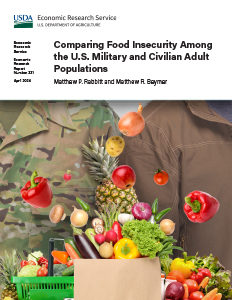Comparing Food Insecurity Among the U.S. Military and Civilian Adult Populations
- by Matthew P. Rabbitt and Matthew R. Beymer
- 4/11/2024
Overview
Readiness is a cornerstone of military service. Military readiness includes cognitive and physical abilities to train and execute missions. Previous studies among civilians demonstrate that food security is either directly or indirectly associated with cognitive function and body mass index. Therefore, food security is vital to maintaining military readiness. While no analyses have been conducted to date on the prevalence of food insecurity for a representative sample of the active duty U.S. military, studies of individual military installations have demonstrated food insecurity rates between 15 percent and 33 percent, but these samples could not be generalized. In this analysis the authors compared food insecurity among the U.S. active duty military and civilian adult populations, using data from the 2018 and 2020 Status of Forces Survey of Active Duty Members and the Current Population Survey Food Security Supplement.
How to Cite:
Rabbitt, M.P., & Beymer, M.R. (2024). Comparing food insecurity among the U.S. military and civilian adult populations (Report No. ERR-331). U.S. Department of Agriculture, Economic Research Service. https://doi.org/10.32747/2024.8374828.ers
Download
-
Entire report
Download PDF -
Report summary
Download PDF

